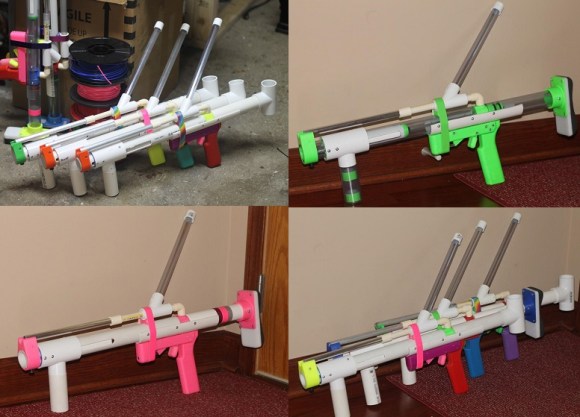
This spectacular bullpup nerf gun was developed by the guys over at Mostly Harmless Arms. It is complete with 3D printed parts in a variety of colors. The Extension Spring/Latex Tubing (ESLT) Blasters were based off of [Kane]’s snapoid trigger design with 1/4″ aluminum for the plunger rods which worked out really well. [Prince Edward] adapted [Kane]’s work and modified it with 3D printing in mind. The original post from 2012 gave an in-depth look into where the idea started.
The documentation for all the printed part files and high quality photos can be found on Nerfhaven. It is really nice to see such a clean design that can be fashioned together on a relatively small budget. This makes these playful nerf blasters easy to duplicate, allowing for a full out office war. Granted, access to a 3D printer is needed, but additive manufacturing devices are getting more and more common these days. Now it’s just a matter of seeing how well they work, which can be deduced from the videos after the break:
Firing Demo:
Explanation Video:
[Thanks for the tip Langley!!]















*sigh* At least this is a low pressure air + PVC pipe application. Kinda neat, surprised this wasn’t crowd funded and injection molded.
OH MY GOD! Not a 3D printed (nerf) gun, we MUST outlaw 3D printers AT ONCE!!!!
Watching the second video with the constantly moving autofocus was painful
yes, that is incredibly annoying
They call them blasters.
The community on Nerfhaven.com is mostly made up of makers and modders. Any crowd funding would probably be for parts or ammo, not a complete blaster.
that nerf blaster was originally developed by the modders on nerf have just because they 3d printed what is usually a clothes pin doesnt mean they did it. do your research and give credit where it is due. also this is not the first time nerf modders have used 3d printers
Well, /technically/ Mullberry, even Carbon didn’t really create a revolutionary catch with the SNAP series. All of the various plunger retention mechanisms that we commonly use have been in use for decades in other applications. The beauty of the SNAP catch is how easily it is replicated with random hardware from around the house, but they require tuning and occasional overhaul. The beauty of the ESLT catch is how smoothly they operate and solidly catch even with high tension, but they require a printer or additional machining time.